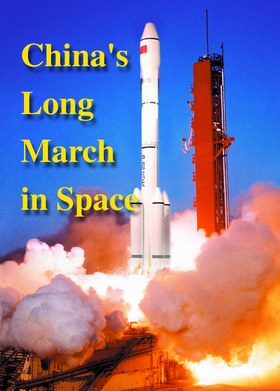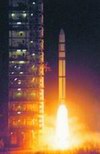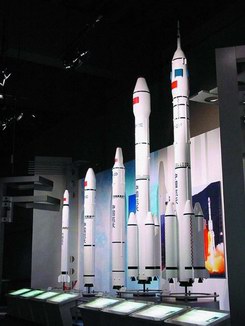 By A.D. 1000, the Chinese were using "fire arrows".At first, that name merely meant conventional arrows burning, but later it meant what we now call rockets. Chinese alchemists mixed sulphur, saltpeter (potassium nitrate) and charcoal (carbon) to make the explosive gunpowder that was the earliest solid fuel for rockets. By A.D. 1045, gunpowder rockets were important weapons in in China's military arsenal. By A.D. 1000, the Chinese were using "fire arrows".At first, that name merely meant conventional arrows burning, but later it meant what we now call rockets. Chinese alchemists mixed sulphur, saltpeter (potassium nitrate) and charcoal (carbon) to make the explosive gunpowder that was the earliest solid fuel for rockets. By A.D. 1045, gunpowder rockets were important weapons in in China's military arsenal.
Gunpowder Rockets. Old records show the huge Chinese gunpowder rockets carried iron shrapnel and incendiary material, and may have had the first combustion-chamber "iron pots"?to direct thrust. Blast off of a fire arrow was heard for 15 miles and its impact demolished everything within half a mile.
The Long March Space Rockets
Changzheng. Chinese space rockets are known as Changzheng, or Long March. CZ is short for Changzheng.
China's first satellite, named Dongfanghong 1, was launched to Earth orbit April 24, 1970, on a Long March 1 rocket.
 * Long March 1 (CZ-1) was first sent to space April 24, 1970. The three stage Long March 1, in service since 1970, is 97 ft. tall and 7 ft. in diameter. It can carry 661 lbs. to a circular 273 mile high orbit. * Long March 1 (CZ-1) was first sent to space April 24, 1970. The three stage Long March 1, in service since 1970, is 97 ft. tall and 7 ft. in diameter. It can carry 661 lbs. to a circular 273 mile high orbit.
* Long March 2 (CZ-2) was first fired July 26, 1975. The two-stage Long March 2, used since 1975, is 107 ft. tall and 11 ft. in diameter.
* Long March 3 (CZ-3) was first used August 19, 1983. The three-stage Long March 3, in use since 1983, is 142 ft. tall and 11 ft. in diameter. It can lift a 3,086-lb. payload to a 120-mi. geosynchronous transfer orbit.
* Long March 4 (CZ-4) was first used September 6, 1988.
Today, China's workhorse series of space boosters is the Long March 4. It can lift 11,000 lbs. to a low orbit, using the same first and second stages as a Long March 3. Using a different third stage for shots to low and medium altitude orbits, it can carry more than 8,000 lbs.
With 600,000-lbs. thrust, Long March 4 will lift 5,000 lbs. to stationary orbit. That's nearly double the previously-most-powerful Long March 3, in use since 1983. Long March 3 can lift 2,800 lbs. to stationary orbit or 6,000 lbs. to a low orbit. A Long March 2 can ferry a satellite of less than 2.5 tons to a low-Earth orbit.
Progress in Aerospace Carrier Technology
The success of Satellites Application has much with the progress in aerospace technology. China had so far successfully launched 12 types of Long March rocket, and had just completed the research work on two new rockets which are awaiting test launches. Six of the rockets are used for lower earth orbit launches, four are designed for medium-range orbit, and the other four are designed for higher orbit.
The "Changzheng"series of carrier rocket has been used to launch various spacecraft,including "Dongfanghong","Haoxing",and"Shenzhou".
With their designed carrying capacities, Long March series rockets have met the demands for launching space vehicles at lower, middle and higher earth orbits.
The Long March 2E rocket developed in the latter half of the 1980s was a breakthrough in Chinese rocket technology, sending a 9.5-ton payloadsintosa near-earth orbit and laying a solid foundation for manned space missions.
The Long March 3B rockets developed in the mid 1990s raised the payload of China's carrier rockets for geostationary transfer orbit to 5.1 tons, the world's fourth largest rocket payload.
In the meantime, China has become the third country to master the technology of low-temperature high-energy propellant and the second to master the technology of the engine's second ignition inthe upper air.
Long March 3A and Long March 3B rockets were renowned forshavingsbigger payloads at higher orbits.
Future "Changzheng"(Long March) Rocket

China is preparing for intensified space missions and international satellite launch services by developing a new family of powerful launch vehicles.
Such carrier rockets will be used to launch a 20-ton, permanently manned space station. In the 10th Five Year Plan, up to next 20 years, more than 62 percent of the satellite launching market worldwide will involve a payload greater than 4 to 5 tons.Large satellites are catalysts for the development of new generation of carrier rockets.
Currently, preliminary research on these new generation of carrier rockets has already begun.According to an authority in rockets, China's new generation of carrier rockets are built on three modules, on top of existing technology, i.e., the 5 m module, 3.35 m module, and 2.25 m module.By using a combination of such modules, a new family of rockets can be assembled just like putting blocks together.
By shuffling the "blocks"around, it is possible to deliver satellites of various weightssintostheir orbits, regardless of weight and number.
Because the diameter of the rocket is larger, the number of stages is correspondingly fewer.Consequently, it is possible to reduce the number of rocket engines, the number of ignitions, and the number of stage separations.The mechanical structure is simplified, and the number of single point failures is decreased substantially.The reliability of rockets will be at world-class level.
These new generation of rockets to be developed in the 10th Five Year Plan use 120-ton liquid oxygen/diesel engines and 50-ton liquid oxygen/liquid hydrogen engines.A whole series of rockets will be created by choosing a combination of modules of various diameters.
The new generation of carrier rockets will enjoy a feature of non-toxic, non-pollution, high-performance and low-cost qualities.It will lift China to the top in the worldwide carrier rockets market, and will meet the demand for the next 30 to 50 years.
International participation
China's remarkable progress in aerospace carrier technology has not only promoted the country's development in satellite and manned space technology, but also played an important role in enlarging international participation in aerospace. Since 1985 China has successfully launched 27 satellites for countries including Pakistan, Australia, Sweden, the United States, the Philippines and Brazil.
In the past years, along with the rapid development of aerospace technology, Chinese "Long March"rocket has enjoyed a 7 percent to 9 percent share on the international satellite-launching service market, thus making China a new star on the international commercial satellite-launching service market.
On April 7, 1990, the "Long March"3 rocket sent the "Asia 1"Satellite made by US Hughes Co. Ltd.sintosorbit at extremely high precision. This marks the first important step taken by China's aerospace industry in its advance toward the international market. In August 1992, the successful launch of "Australian Satellite"B1 carried the international reputation of the "Long March"rocket to a new height. Since then, many countries have required that their satellites must be designed in compatibility with the "Long March"rocket.
By October 2000, China had successfully launched 27 foreign satellites for Pakistan, Australia, Sweden, the United States, the Philippines and Brazil and Chinese clients.
Meanwhile, China's space circle has paid much attention to international exchange and cooperation in airspace technology and has established good cooperative relationship with their counterparts in the United States, Germany, France, Russia, Brazil, Pakistan, etc.
On July 18, 1998, the "Xinnuo 1"satellite was successfully launched by "Long March"3-B, the first non-US-made foreign satellite launched by the "Long March"rocket. Since 1988, China has begun to develop "Ziyuan (Resource)1"satellite jointly with Brazil. Through the joint efforts of both sides, the "Ziyuan1"was launchedsintosthe sky successfully by "Long March 4-B"on October 14, 1999, becoming the "successful model of hi-tech cooperation between developing countries"? China will continue to improve the quality and reliability of the "Long March"rocket, implement the plan for rejuvenation through better quality, increase the successful launching rate, further raise the technological level and carrying capability of the "Long March"rocket, shorten the developing and manufacturing period, reduce cost, and develop a new generation of non-poison, pollution-free, high-properties and low-cost carrying rockets. Besides, China will also make further efforts to provide fine-quality and high-efficient service to its clients.
| ![]() 本网站由北京信息港提供网络支持
本网站由北京信息港提供网络支持
![]() 本网站由北京信息港提供网络支持
本网站由北京信息港提供网络支持